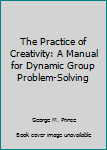The Practice of Creativity: A Manual for Dynamic Group Problem-Solving
Every meeting leader has faced groups that stagnate creatively, or worse turn acrimonious-a dullness or negativity stemming from the group's inability to pursue ideas productively and beyond their... This description may be from another edition of this product.
Format:Paperback
Language:English
ISBN:0020086504
ISBN13:9780020086505
Release Date:January 1972
Publisher:Collier/Macmillan Pub Co
Weight:0.35 lbs.
Customer Reviews
1 rating
About The Book- George Prince and Synectics
Published by Thriftbooks.com User , 19 years ago
Exploring Creativity The field of creativity is still in its infancy. However, much has been published on the topic over the last 50 years, including numerous books and articles by Synectics consultants. These writings include the 1970 book by Synectics co-founder George Prince, "The Practice of Creativity" considered by many a classic in the field. Synectics enjoys a long history, one as rich and eclectic as the many new ideas our clients have developed in our sessions with them. Our history provides insights into the evolution of key business issues as well as the growing need for creative answers to those issues. George Prince and William J.J. Gordon founded the firm in 1960. The two had been part of Arthur D. Little Inc.'s Invention Design Group, a consulting practice responsible for helping companies develop new product concepts. Puzzled by why some meetings were much more fertile than others, Gordon and Prince believed it had less to do with the people in the room and more to do with the dynamics that were operating unbeknownst to those people in the room. To understand those dynamics, Prince and Gordon taped thousands of hours of new product development meetings. They studied how people were interacting. The tapes revealed significant differences in meetings that generated inventions and those that didn't. The founders then turned their observations into methods that replicated the techniques used informally by successful inventors and entrepreneurs. Ever since, Synectics has advanced its approaches to helping people in organizations to generate superior ideas, with steadily increasing impact. Synectics is based on a simple concept for problem solving and creative thinking - you need to generate ideas, and you need to evaluate ideas. Whilst this may be stating the obvious the methods used to perform these two tasks are extremely powerful. Synectics is an approach to creative thinking that depends on understanding together that which is apparently different. Its main tool is analogy or metaphor. The approach, which is often used by groups, can also help students develop creative responses to problem solving, to retain new information, to assist in generating writing, and to explore social and disciplinary problems. It helps users break existing minds sets and internalize abstract concepts. Synectics can be used with all ages and works well with those who withdraw from traditional methods. Teacher-facilitators can use synectics in the classroom by leading students to: * Describe the Topic: The facilitator selects a word or topic then asks students to describe the topic, either in small group discussions or by individually writing a paragraph; e.g., MUSIC. * Create Direct Analogies: The facilitator selects another word or topic then asks the students to generate a list that would have the same characteristics as those words or phases listed in Step 1 (a direct analogy is set up to make comparisons between the two words, ima





